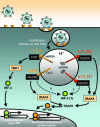TLR7: A new sensor of viral infection - PubMed (original) (raw)
Comment
TLR7: A new sensor of viral infection
K Crozat et al. Proc Natl Acad Sci U S A. 2004.
No abstract available
Figures
Fig. 1.
What is the role of mTLR7 in the antiviral response? Many ssRNA viruses (including VSV and influenza viruses) engage host cell receptors that trigger endocytosis. Once within endosomes, these enveloped virions fuse with the membrane to release their capsids into the cytosol. However, maturation and acidification of the endosomal vesicle may damage some viral particles, leading to ssRNA release. Human TLR8 (hTLR8) and mouse TLR7 (mTLR7), which are only expressed within endosomal membranes, recognize ssRNA [especially poly(U) and poly(U/G) motifs in the case of hTLR8], which triggers activation. Their associated signaling pathways involve myeloid differentiation factor 88 (MyD88), IL-1 receptor-associated kinase 4 (IRAK4), and tumor necrosis factor receptor-associated factor 6 (TRAF6), which lead to NF-κB activation and inflammatory cytokine production. mTLR7 and hTLR8 might also activate a MyD88-independent pathway involving IFN regulatory factor 3 (IRF-3), or perhaps another IRF family member. This activation leads to the expression of type I IFNs. mTLR7 may also recognize ssRNA derived from viruses that release directly their capsids into the cytosol through plasma membrane fusion (data not shown). The mechanism by which ssRNA would find its way to the endosome in this case is not clear. TLRs 3 and 9 are also activated by viral nucleic acids: dsRNA- and DNA-bearing unmethylated CpG motifs, respectively.
Comment on
- Recognition of single-stranded RNA viruses by Toll-like receptor 7.
Lund JM, Alexopoulou L, Sato A, Karow M, Adams NC, Gale NW, Iwasaki A, Flavell RA. Lund JM, et al. Proc Natl Acad Sci U S A. 2004 Apr 13;101(15):5598-603. doi: 10.1073/pnas.0400937101. Epub 2004 Mar 19. Proc Natl Acad Sci U S A. 2004. PMID: 15034168 Free PMC article.
Similar articles
- TLR ignores methylated RNA?
Ishii KJ, Akira S. Ishii KJ, et al. Immunity. 2005 Aug;23(2):111-3. doi: 10.1016/j.immuni.2005.08.003. Immunity. 2005. PMID: 16111629 Review. - Expression and function of Toll-like receptors in eosinophils: activation by Toll-like receptor 7 ligand.
Nagase H, Okugawa S, Ota Y, Yamaguchi M, Tomizawa H, Matsushima K, Ohta K, Yamamoto K, Hirai K. Nagase H, et al. J Immunol. 2003 Oct 15;171(8):3977-82. doi: 10.4049/jimmunol.171.8.3977. J Immunol. 2003. PMID: 14530316 - The interferon regulatory factor, IRF5, is a central mediator of toll-like receptor 7 signaling.
Schoenemeyer A, Barnes BJ, Mancl ME, Latz E, Goutagny N, Pitha PM, Fitzgerald KA, Golenbock DT. Schoenemeyer A, et al. J Biol Chem. 2005 Apr 29;280(17):17005-12. doi: 10.1074/jbc.M412584200. Epub 2005 Jan 28. J Biol Chem. 2005. PMID: 15695821 - Immunology. After the toll rush.
O'Neill LA. O'Neill LA. Science. 2004 Mar 5;303(5663):1481-2. doi: 10.1126/science.1096113. Science. 2004. PMID: 15001768 No abstract available. - Recognition of pathogen-associated molecular patterns by TLR family.
Akira S, Hemmi H. Akira S, et al. Immunol Lett. 2003 Jan 22;85(2):85-95. doi: 10.1016/s0165-2478(02)00228-6. Immunol Lett. 2003. PMID: 12527213 Review.
Cited by
- Cell damage shifts the microRNA content of small extracellular vesicles into a Toll-like receptor 7-activating cargo capable to propagate inflammation and immunity.
Salvi V, Gaudenzi C, Mariotti B, Giongrandi G, Alacqua S, Gianello V, Schioppa T, Tiberio L, Ceribelli A, Selmi C, Bergese P, Calza S, Del Prete A, Sozzani S, Bazzoni F, Bosisio D. Salvi V, et al. Cell Commun Signal. 2024 Nov 8;22(1):536. doi: 10.1186/s12964-024-01924-z. Cell Commun Signal. 2024. PMID: 39516877 Free PMC article. - Engineered Cancer Nanovaccines: A New Frontier in Cancer Therapy.
Wang Y, Liu C, Fang C, Peng Q, Qin W, Yan X, Zhang K. Wang Y, et al. Nanomicro Lett. 2024 Sep 30;17(1):30. doi: 10.1007/s40820-024-01533-y. Nanomicro Lett. 2024. PMID: 39347944 Free PMC article. Review. - Multi-epitope vaccine design using in silico analysis of glycoprotein and nucleocapsid of NIPAH virus.
Kumar A, Misra G, Mohandas S, Yadav PD. Kumar A, et al. PLoS One. 2024 May 10;19(5):e0300507. doi: 10.1371/journal.pone.0300507. eCollection 2024. PLoS One. 2024. PMID: 38728300 Free PMC article. - Pharmacological activation of TLR7 exerts inhibition on the replication of EV-D68 in respiratory cells.
Li H, Huang Y, Yang Q, Zhang Z, Shen S, Guo H, Wei W. Li H, et al. J Virol. 2024 Jun 13;98(6):e0043424. doi: 10.1128/jvi.00434-24. Epub 2024 May 1. J Virol. 2024. PMID: 38690875 Free PMC article. - An RNA-hydrolyzing recombinant minibody prevents both influenza A virus and coronavirus in co-infection models.
Luong QXT, Hoang PT, Lee Y, Ayun RQ, Na K, Park S, Lin C, Ho PT, Lee TK, Lee S. Luong QXT, et al. Sci Rep. 2024 Apr 11;14(1):8472. doi: 10.1038/s41598-024-52810-0. Sci Rep. 2024. PMID: 38605110 Free PMC article.
References
- Beutler, B. & Rietschel, E. T. (2003) Nat. Rev. Immunol. 3, 169-176. - PubMed
- Poltorak, A., He, X., Smirnova, I., Liu, M.-Y., Van Huffel, C., Du, X., Birdwell, D., Alejos, E., Silva, M., Galanos, C., et al. (1998) Science 282, 2085-2088. - PubMed
- Hemmi, H., Kaisho, T., Takeuchi, O., Sato, S., Sanjo, H., Hoshino, K., Horiuchi, T., Tomizawa, H., Takeda, K. & Akira, S. (2002) Nat. Immunol. 3, 196-200. - PubMed
- Jurk, M., Heil, F., Vollmer, J., Schetter, C., Krieg, A. M., Wagner, H., Lipford, G. & Bauer, S. (2002) Nat. Immunol. 3, 499. - PubMed
Publication types
MeSH terms
Substances
LinkOut - more resources
Full Text Sources
Other Literature Sources
